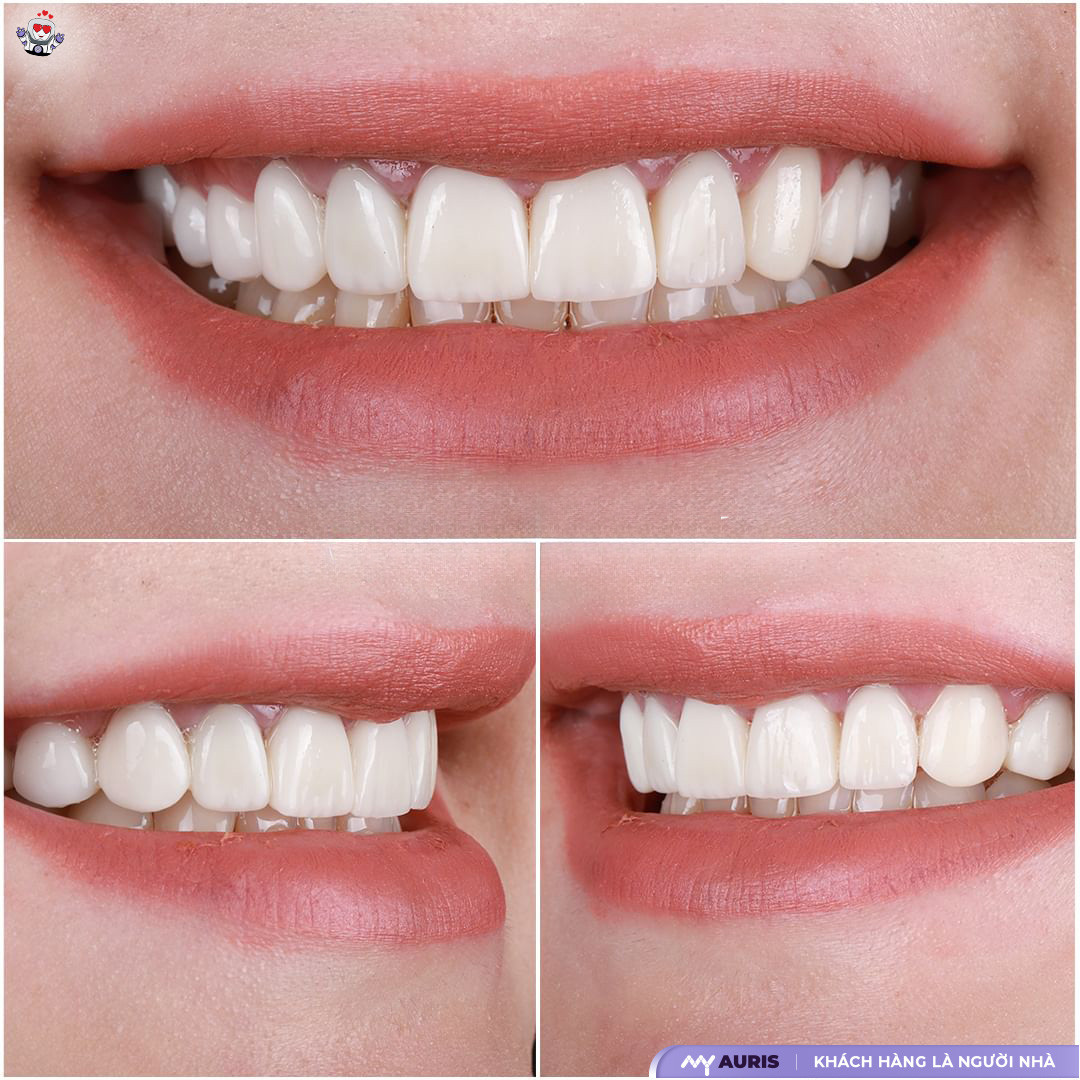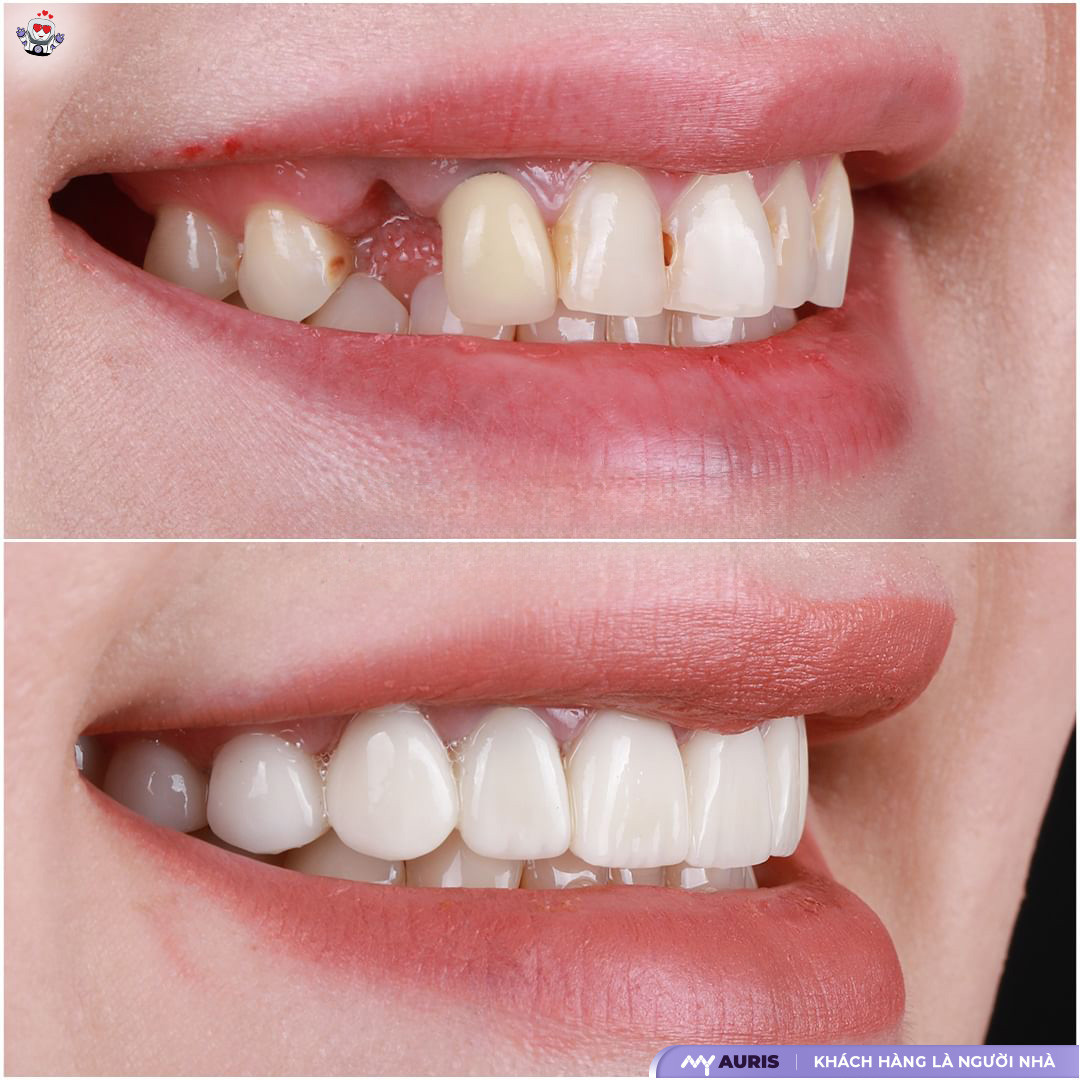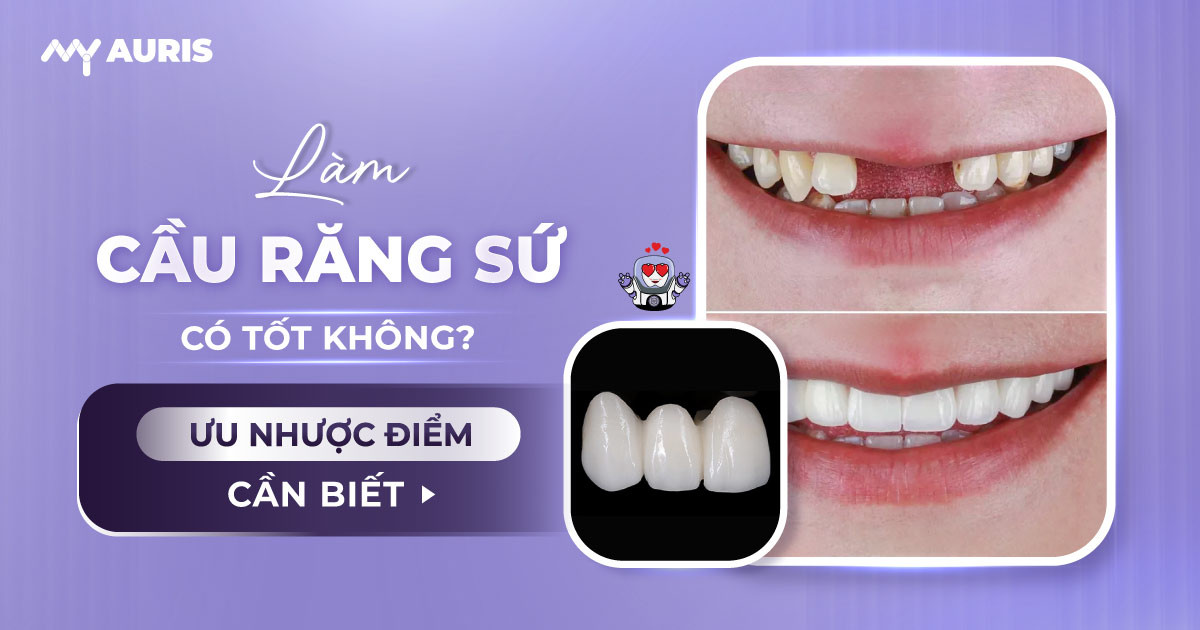Currently, ceramic bridges are a solution for replacing missing teeth chosen by many people thanks to their faster implementation time and more reasonable cost compared to implants. So is porcelain dental bridge good and durable? This is a common question of many patients when learning about dental restoration methods. In the article below, My Auris will help you better understand the method of making porcelain dental bridges – from the concept, advantages and disadvantages, to the detailed implementation process. The latest information will help you make the right and most suitable choice for your oral health.
What is a porcelain dental bridge?
Ceramic dental bridge is a popular method of restoring missing teeth, especially effective in cases where 1-3 adjacent teeth are lost. This method uses the technique of grinding down 2 real teeth located on both sides of the tooth loss position to create real teeth as support for a row of porcelain teeth including false teeth in the middle and two porcelain crowns at both ends, which are then fixed onto the abutment teeth.
Normally, porcelain dental bridges include 2, 3 or 4 porcelain crowns firmly linked together. The middle part is 1 or 2 false teeth to replace lost teeth. The mandatory requirement is that the real teeth being ground must be healthy to be able to firmly support the porcelain dental bridge, ensuring sustainability and aesthetics in the long term.
A big plus point of the porcelain dental bridge is that the cost is lower than the dental implant option, and the implementation time is faster, without surgery or bone integration time. This is the optimal choice for those who do not have the financial means to implant, or in cases where the teeth adjacent to the missing tooth are still healthy and the adjacent teeth need to be covered with porcelain to protect.

Is a porcelain dental bridge good? no?
Advantages of making porcelain bridges
- High aesthetics
Is porcelain dental bridge good? The answer is yes, especially when considering high aesthetics. Porcelain dental bridges help restore lost teeth with the same size, shape and color as real teeth, creating new teeth that are naturally beautiful and in harmony with the entire jaw. Thanks to that, patients will feel confident in daily communication without worrying about missing teeth.
- Fast implementation time
Compared to dental implants, which require a period of 3-6 months for dental integration, porcelain bridges only take 2-5 days to complete. From examination to completion, it only takes 1-2 visits, helping patients quickly have beautiful, straight teeth. This is achieved thanks to the application of modern digital technology and advanced manufacturing techniques, allowing to quickly restore teeth while ensuring quality.
- Restore chewing function quickly
With the bridging solution Porcelain teeth, patients can restore chewing ability similar to real teeth, reaching about 60–70%. Porcelain crowns are fixed and do not move when eating and drinking, allowing you to chew normally after just a few days. This is a great advantage of porcelain dental bridges that many people are choosing to replace other methods.
- Cost savings
The more economical tooth restoration option is porcelain bridges, especially compared to implants. The difference in price comes from the simpler porcelain crown process, no need for deep surgical intervention, and lower material costs. Therefore, this is the ideal choice for those who want fast, beautiful and affordable tooth restoration.

Disadvantages of Porcelain dental bridge
Although considered one of the popular tooth restoration solutions, porcelain dental bridge still has many notable limitations. To make the most suitable choice, you need to clearly understand the disadvantages of porcelain dental bridges from a dental professional perspective:
- High rate of invasion of real teeth, affecting adjacent teeth
One of the biggest disadvantages of porcelain dental bridges is the rate The rate of tooth invasion is very high. Specifically, the teeth adjacent to the lost tooth must be ground down to serve as supports for the bridge. This process will cause the teeth on both sides to wear out, lose the enamel and dentin layer, making the abutment teeth weaker and even loose. At that time, the porcelain crown cannot be supported and the doctor is forced to prescribe another tooth support, affecting overall oral health.
- Mastication function is not guaranteed in the long term
A common disadvantage of porcelain dental bridges is the function Long-term chewing is not guaranteed. This method can only restore chewing function about 70%, because porcelain bridges do not prevent bone loss.amm. Over time, after a few years, the tooth posts show signs of gum recession, even two tooth posts have deep gum recession, leading to a significant decrease in chewing ability.
- Inability to prevent jaw bone loss
Unlike implants, porcelain bridges only replace parts tooth crowns and filling in the missing tooth space, is completely incapable of preventing bone loss. When the jawbone is destroyed, the patient is susceptible to complications such as malocclusion, gapped teeth, receding gums, and exposure of abutment tooth roots, affecting aesthetics and creating opportunities for bacteria to enter the tooth socket, increasing the risk of infection.
- Limit the candidates
Not everyone is suitable for porcelain dental bridges. This method is only effective in cases where one tooth is lost or several teeth are missing, provided that the two abutment teeth are strong and do not have dental disease. In particular, it is difficult for people who have lost tooth number 7, because there is not enough support to make a bridge.
- Does not apply to spaces with many missing teeth
In situations where too many teeth are lost or the entire jaw is lost, the abutment teeth are not strong enough to support the crown, leading to to treatment failure. At this time, the doctor will prescribe another, more optimal tooth restoration method, typically dental implants, to achieve long-term results.
- Short service life
Another disadvantage of ceramic dental bridges is their short service life, on average only maintained for 3 – 5 years. The durability of a dental bridge depends on many factors such as grinding technique, ceramic crown material, health of abutment teeth, bite condition and daily oral hygiene. If not properly cared for, the lifespan can be further shortened.
In what cases should a porcelain dental bridge be applied?
Method of making a porcelain dental bridge is a restoration solution commonly prescribed by dentists in the treatment of tooth loss, especially when the patient is not eligible for an implant. Below are specific cases where porcelain dental bridges should be applied:
Loss of 1-3 adjacent teeth, while the real teeth on both sides of the tooth loss space are still healthy to take on the role of supporting the bridge.
People with tooth loss but The jawbone has not been resorbed, meaning the jawbone is strong enough to support a porcelain bridge without surgery.
In cases where it is necessary to quickly restore chewing function and improve aesthetics, especially with teeth located in the smile area.
The patient does not are healthy enough to undergo surgery or do not want to undergo implant surgery.
People who do not have the financial means to choose the implant method – which has a much higher cost than the traditional method.Porcelain tooth tumor.
The application of porcelain dental bridges not only helps patients restore aesthetics quickly, but also ensures stable chewing ability in a short time. However, to achieve optimal results, the patient needs to have the dentist prescribe the correct condition and have it done at a reputable dental facility with highly specialized doctors and modern technology.
Is porcelain dental bridge durable?
Ceramic dental bridges are a durable tooth restoration solution, chosen by many people thanks to their high hardness and good chewing ability compared to real teeth. According to professional experience, the average durability of a porcelain dental bridge can reach 7–10 years, even longer if properly cared for.
However, the question “How long can a porcelain dental bridge last?” also depends on factors such as:
Ceramic teeth material (in which all-ceramic porcelain teeth are more durable than metal porcelain teeth),
Condition of abutment teeth before restoration,
Doctor’s skills,
And especially how to take care of your teeth after making a bridge.
If done with the right technique, combined with the use of good quality ceramic materials and proper post-treatment care, a porcelain bridge can completely meet your long-term chewing needs and have good aesthetics.
Before deciding, you should discuss carefully with your doctor, to get advice on choosing the right type of dental bridge, and at the same time understand clearly how to care for your teeth to ensure long-term effectiveness.
Is porcelain dental bridge painful? does it?
Is porcelain dental bridge painful? This is a common question for those considering replacing missing teeth. According to the dentist and compiled from many reviews of patients making porcelain bridges, the process of making porcelain bridges is painless, thanks to the use of anesthetics and the application of modern dental techniques.
Before grinding teeth, the doctor will give local anesthesia to ensure the patient does not feel uncomfortable. The grinding process is performed using precise grinding techniques, only affecting the enamel layer, not affecting the tooth pulp, so there is absolutely no pain for the patient during the treatment process.
However, when the anesthetic wears off, some people may feel a bit sore or sensitive in the area of the tooth that has been ground, due to the protective enamel layer on the outside. be ground away. This condition may appear more clearly when eating hot or cold foodsbreathe cold air. The feeling of sensitivity is greatest in the first 1-2 days, then gradually decreases over the next 4-5 days, and usually disappears completely with proper care.
To limit pain and increase treatment effectiveness, advice from experts is to choose a reputable dentist. Here, you will be directly examined and treated by a skilled doctor, with support from modern equipment, helping the treatment process take place quickly, accurately and painlessly. Thanks to that, the patient feels comfortable, no longer worried, and no longer stressed during the restoration process.

Process of making medical-standard porcelain dental bridges at My Auris Dental
At My Auris Dental, the process of making porcelain dental bridges is carried out methodically, scientifically, according to standards Ministry of Health aims to ensure chewing function and long-term aesthetics for customers. Below are the specific steps in the process:
Step 1: Examination and dental check
First, the specialist will examine the general oral condition combined with X-rays to determine the condition of the jaw bone, the number of teeth that need restoration, and evaluate the level of suitability. Suitable for making porcelain dental bridges. Based on the results, the doctor will create a detailed treatment plan, ensuring maximum effectiveness and safety.
Step 2: Anesthetize and grind the tooth base
Before the procedure, the customer will be anesthetized in the tooth area that needs treatment to reduce pain and help the process go more smoothly. Then, the doctor proceeds to grind the tooth stump according to a carefully calculated ratio, ensuring it does not invade the real tooth too much but still meets the standards to firmly support the porcelain bridge.
Step 3: Take an impression of the jaw and temporarily restore the tooth
Immediately after grinding the stump, the doctor will take a sample impression accurate jaw and sent to a specialized laboratory to make the most accurate porcelain teeth according to each tooth position. At the same time, attaching temporary crowns helps ensure aesthetics and avoid sensitivity while waiting for the official crown design.
Step 4: Attach the porcelain bridge
After completing the fabrication, the porcelain bridge will be attached to the ground tooth post. The doctor will carefully check whether the crown matches the tooth abutment or not, and whether there is any difference, exposure or bite misalignment, to ensure the best chewing ability and limit future risks.
Step 5: Check and make a follow-up dental appointment
Finally, the doctor will check the durability of the porcelain bridge, ensuring it does not cause difficulty when used in daily activities. At the same time, schedule regular follow-up visits to check the condition of the teeth and maintain long-term effectiveness.
At My Auris Dental, if the porcelain bridge making process is performed by a highly skilled doctor, using quality porcelain teeth and the customer takes good oral care, the porcelain bridge can be used for a long time, while perfectly meeting the chewing requirements. and aesthetics.





